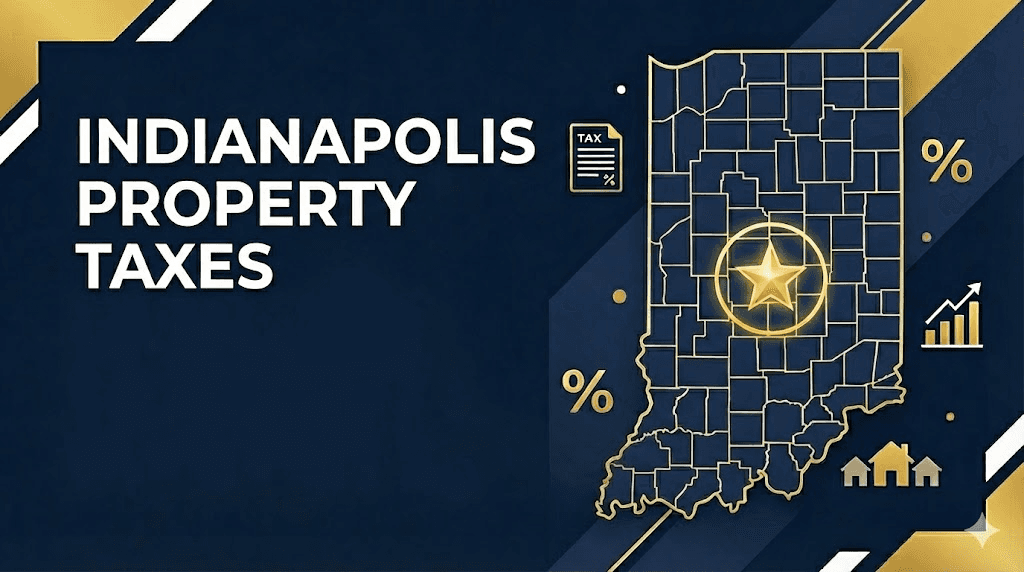If you’ve been scrolling Zillow from the coasts, you’ve probably noticed something shocking: the price of a three-bedroom rental in Indianapolis is often less than half the price of a one-bedroom condo in L.A. or New York. No wonder Indy has become a hotspot for out-of-state investors.
As of mid-2025, the median home price in Indianapolis is around $245,000, compared to the U.S. median of $412,000. Add in steady population growth (driven by remote workers and corporate relocations) and a rental market where average rents jumped 6% in 2024, and you’ve got a formula for strong, affordable cash flow.
But how do you actually buy properties here if you live in Chicago, Austin, or across the country? That’s where remote investing strategies come in.
Why Indianapolis Attracts Out-of-State Investors
Affordable entry points
Indianapolis homes often cash flow right out of the gate, something that’s almost impossible in expensive coastal markets.
Strong rental demand
With Indy being one of the top U-Haul migration destinations and major employers (Eli Lilly, Salesforce, Cummins) expanding, demand for rental housing has stayed strong.
Stable appreciation
From 2019 to 2024, home values in Marion County grew nearly 41%. Investors aren’t just buying for cash flow—they’re banking on long-term appreciation too.
Strategies for Remote Investing in Indianapolis
Partner with an investor-friendly agent
Not all real estate agents understand cap rates, ROI, or tenant turnover risk. You’ll want someone who invests themselves and can flag which neighborhoods are great for long-term rentals vs. flips.
At Roots Realty, our agents double as investors—we help you evaluate deals with an investor’s mindset, not just a salesperson’s.
Hire a reliable property manager
Your property manager is the quarterback once you close. They’ll handle:
Tenant placement and screening
Rent collection and accounting
Maintenance calls and vendor management
Regular property inspections
A good manager is the difference between a hands-off investment and a constant headache.
Use technology to bridge the distance
You don’t have to hop on a plane every time. Out-of-state investors rely on:
Video tours for showings and inspections
Detailed inspection reports with photos
Cloud-based property management portals to track rent, expenses, and communication
The Roots Realty Advantage
We know remote investors need boots on the ground. That’s exactly what our team provides:
Neighborhood insight: We’ll break down which Indy neighborhoods match your goals, whether that’s cash flow in Garfield Park or appreciation in Riverside.
Deal flow: Access to off-market opportunities that never hit Zillow.
Trustworthy referrals: Property managers, inspectors, and contractors we use for our own investments.
Q&A: Out-of-State Investing in Indy
What’s the average rent in Indianapolis in 2025?
As of early 2025, the average rent for a single-family home in Indy is around $1,450/month, with higher numbers near downtown and Broad Ripple.
Can I buy Indianapolis property without visiting?
Yes. Many investors close entirely remotely using video tours, digital signing tools, and third-party inspectors. We’ve helped dozens of out-of-state clients do this seamlessly.
Which Indy neighborhoods are best for investors?
It depends on your goals. Areas like Irvington and Garfield Park are strong for affordable rentals, while Fountain Square and Riverside offer more appreciation upside. (Check out our Indianapolis Neighborhood Guide for Real Estate Investors).
Do I need an LLC to buy property in Indianapolis?
Not necessarily. Many investors start in their own name and later transfer properties to an LLC for liability and tax purposes. Talk to a CPA to decide what works best for you.
Relevant Information for You
Investor Resources: Roots Investor Hub
BRRRR in Indianapolis: How to Succeed with the 2025 Strategy
Top Indianapolis Neighborhoods for Rental Property Investment
Indianapolis is one of the most approachable markets for out-of-state investors. Affordable prices, strong rental demand, and steady appreciation make it a compelling play—but only if you have the right team locally.
At Roots Realty Co., we’re more than agents—we’re investors ourselves. If you’re ready to buy in Indy remotely, we’ll be your eyes, ears, and boots on the ground.
Ready to start your out-of-state investing journey in Indy? Connect with Roots Realty Co. today and let’s find your first (or next) rental property.
If you’ve been scrolling Zillow from the coasts, you’ve probably noticed something shocking: the price of a three-bedroom rental in Indianapolis is often less than half the price of a one-bedroom condo in L.A. or New York. No wonder Indy has become a hotspot for out-of-state investors.
As of mid-2025, the median home price in Indianapolis is around $245,000, compared to the U.S. median of $412,000. Add in steady population growth (driven by remote workers and corporate relocations) and a rental market where average rents jumped 6% in 2024, and you’ve got a formula for strong, affordable cash flow.
But how do you actually buy properties here if you live in Chicago, Austin, or across the country? That’s where remote investing strategies come in.
Why Indianapolis Attracts Out-of-State Investors
Affordable entry points
Indianapolis homes often cash flow right out of the gate, something that’s almost impossible in expensive coastal markets.
Strong rental demand
With Indy being one of the top U-Haul migration destinations and major employers (Eli Lilly, Salesforce, Cummins) expanding, demand for rental housing has stayed strong.
Stable appreciation
From 2019 to 2024, home values in Marion County grew nearly 41%. Investors aren’t just buying for cash flow—they’re banking on long-term appreciation too.
Strategies for Remote Investing in Indianapolis
Partner with an investor-friendly agent
Not all real estate agents understand cap rates, ROI, or tenant turnover risk. You’ll want someone who invests themselves and can flag which neighborhoods are great for long-term rentals vs. flips.
At Roots Realty, our agents double as investors—we help you evaluate deals with an investor’s mindset, not just a salesperson’s.
Hire a reliable property manager
Your property manager is the quarterback once you close. They’ll handle:
Tenant placement and screening
Rent collection and accounting
Maintenance calls and vendor management
Regular property inspections
A good manager is the difference between a hands-off investment and a constant headache.
Use technology to bridge the distance
You don’t have to hop on a plane every time. Out-of-state investors rely on:
Video tours for showings and inspections
Detailed inspection reports with photos
Cloud-based property management portals to track rent, expenses, and communication
The Roots Realty Advantage
We know remote investors need boots on the ground. That’s exactly what our team provides:
Neighborhood insight: We’ll break down which Indy neighborhoods match your goals, whether that’s cash flow in Garfield Park or appreciation in Riverside.
Deal flow: Access to off-market opportunities that never hit Zillow.
Trustworthy referrals: Property managers, inspectors, and contractors we use for our own investments.
Q&A: Out-of-State Investing in Indy
What’s the average rent in Indianapolis in 2025?
As of early 2025, the average rent for a single-family home in Indy is around $1,450/month, with higher numbers near downtown and Broad Ripple.
Can I buy Indianapolis property without visiting?
Yes. Many investors close entirely remotely using video tours, digital signing tools, and third-party inspectors. We’ve helped dozens of out-of-state clients do this seamlessly.
Which Indy neighborhoods are best for investors?
It depends on your goals. Areas like Irvington and Garfield Park are strong for affordable rentals, while Fountain Square and Riverside offer more appreciation upside. (Check out our Indianapolis Neighborhood Guide for Real Estate Investors).
Do I need an LLC to buy property in Indianapolis?
Not necessarily. Many investors start in their own name and later transfer properties to an LLC for liability and tax purposes. Talk to a CPA to decide what works best for you.
Relevant Information for You
Investor Resources: Roots Investor Hub
BRRRR in Indianapolis: How to Succeed with the 2025 Strategy
Top Indianapolis Neighborhoods for Rental Property Investment
Indianapolis is one of the most approachable markets for out-of-state investors. Affordable prices, strong rental demand, and steady appreciation make it a compelling play—but only if you have the right team locally.
At Roots Realty Co., we’re more than agents—we’re investors ourselves. If you’re ready to buy in Indy remotely, we’ll be your eyes, ears, and boots on the ground.
Ready to start your out-of-state investing journey in Indy? Connect with Roots Realty Co. today and let’s find your first (or next) rental property.
If you’ve been scrolling Zillow from the coasts, you’ve probably noticed something shocking: the price of a three-bedroom rental in Indianapolis is often less than half the price of a one-bedroom condo in L.A. or New York. No wonder Indy has become a hotspot for out-of-state investors.
As of mid-2025, the median home price in Indianapolis is around $245,000, compared to the U.S. median of $412,000. Add in steady population growth (driven by remote workers and corporate relocations) and a rental market where average rents jumped 6% in 2024, and you’ve got a formula for strong, affordable cash flow.
But how do you actually buy properties here if you live in Chicago, Austin, or across the country? That’s where remote investing strategies come in.
Why Indianapolis Attracts Out-of-State Investors
Affordable entry points
Indianapolis homes often cash flow right out of the gate, something that’s almost impossible in expensive coastal markets.
Strong rental demand
With Indy being one of the top U-Haul migration destinations and major employers (Eli Lilly, Salesforce, Cummins) expanding, demand for rental housing has stayed strong.
Stable appreciation
From 2019 to 2024, home values in Marion County grew nearly 41%. Investors aren’t just buying for cash flow—they’re banking on long-term appreciation too.
Strategies for Remote Investing in Indianapolis
Partner with an investor-friendly agent
Not all real estate agents understand cap rates, ROI, or tenant turnover risk. You’ll want someone who invests themselves and can flag which neighborhoods are great for long-term rentals vs. flips.
At Roots Realty, our agents double as investors—we help you evaluate deals with an investor’s mindset, not just a salesperson’s.
Hire a reliable property manager
Your property manager is the quarterback once you close. They’ll handle:
Tenant placement and screening
Rent collection and accounting
Maintenance calls and vendor management
Regular property inspections
A good manager is the difference between a hands-off investment and a constant headache.
Use technology to bridge the distance
You don’t have to hop on a plane every time. Out-of-state investors rely on:
Video tours for showings and inspections
Detailed inspection reports with photos
Cloud-based property management portals to track rent, expenses, and communication
The Roots Realty Advantage
We know remote investors need boots on the ground. That’s exactly what our team provides:
Neighborhood insight: We’ll break down which Indy neighborhoods match your goals, whether that’s cash flow in Garfield Park or appreciation in Riverside.
Deal flow: Access to off-market opportunities that never hit Zillow.
Trustworthy referrals: Property managers, inspectors, and contractors we use for our own investments.
Q&A: Out-of-State Investing in Indy
What’s the average rent in Indianapolis in 2025?
As of early 2025, the average rent for a single-family home in Indy is around $1,450/month, with higher numbers near downtown and Broad Ripple.
Can I buy Indianapolis property without visiting?
Yes. Many investors close entirely remotely using video tours, digital signing tools, and third-party inspectors. We’ve helped dozens of out-of-state clients do this seamlessly.
Which Indy neighborhoods are best for investors?
It depends on your goals. Areas like Irvington and Garfield Park are strong for affordable rentals, while Fountain Square and Riverside offer more appreciation upside. (Check out our Indianapolis Neighborhood Guide for Real Estate Investors).
Do I need an LLC to buy property in Indianapolis?
Not necessarily. Many investors start in their own name and later transfer properties to an LLC for liability and tax purposes. Talk to a CPA to decide what works best for you.
Relevant Information for You
Investor Resources: Roots Investor Hub
BRRRR in Indianapolis: How to Succeed with the 2025 Strategy
Top Indianapolis Neighborhoods for Rental Property Investment
Indianapolis is one of the most approachable markets for out-of-state investors. Affordable prices, strong rental demand, and steady appreciation make it a compelling play—but only if you have the right team locally.
At Roots Realty Co., we’re more than agents—we’re investors ourselves. If you’re ready to buy in Indy remotely, we’ll be your eyes, ears, and boots on the ground.
Ready to start your out-of-state investing journey in Indy? Connect with Roots Realty Co. today and let’s find your first (or next) rental property.
If you’ve been scrolling Zillow from the coasts, you’ve probably noticed something shocking: the price of a three-bedroom rental in Indianapolis is often less than half the price of a one-bedroom condo in L.A. or New York. No wonder Indy has become a hotspot for out-of-state investors.
As of mid-2025, the median home price in Indianapolis is around $245,000, compared to the U.S. median of $412,000. Add in steady population growth (driven by remote workers and corporate relocations) and a rental market where average rents jumped 6% in 2024, and you’ve got a formula for strong, affordable cash flow.
But how do you actually buy properties here if you live in Chicago, Austin, or across the country? That’s where remote investing strategies come in.
Why Indianapolis Attracts Out-of-State Investors
Affordable entry points
Indianapolis homes often cash flow right out of the gate, something that’s almost impossible in expensive coastal markets.
Strong rental demand
With Indy being one of the top U-Haul migration destinations and major employers (Eli Lilly, Salesforce, Cummins) expanding, demand for rental housing has stayed strong.
Stable appreciation
From 2019 to 2024, home values in Marion County grew nearly 41%. Investors aren’t just buying for cash flow—they’re banking on long-term appreciation too.
Strategies for Remote Investing in Indianapolis
Partner with an investor-friendly agent
Not all real estate agents understand cap rates, ROI, or tenant turnover risk. You’ll want someone who invests themselves and can flag which neighborhoods are great for long-term rentals vs. flips.
At Roots Realty, our agents double as investors—we help you evaluate deals with an investor’s mindset, not just a salesperson’s.
Hire a reliable property manager
Your property manager is the quarterback once you close. They’ll handle:
Tenant placement and screening
Rent collection and accounting
Maintenance calls and vendor management
Regular property inspections
A good manager is the difference between a hands-off investment and a constant headache.
Use technology to bridge the distance
You don’t have to hop on a plane every time. Out-of-state investors rely on:
Video tours for showings and inspections
Detailed inspection reports with photos
Cloud-based property management portals to track rent, expenses, and communication
The Roots Realty Advantage
We know remote investors need boots on the ground. That’s exactly what our team provides:
Neighborhood insight: We’ll break down which Indy neighborhoods match your goals, whether that’s cash flow in Garfield Park or appreciation in Riverside.
Deal flow: Access to off-market opportunities that never hit Zillow.
Trustworthy referrals: Property managers, inspectors, and contractors we use for our own investments.
Q&A: Out-of-State Investing in Indy
What’s the average rent in Indianapolis in 2025?
As of early 2025, the average rent for a single-family home in Indy is around $1,450/month, with higher numbers near downtown and Broad Ripple.
Can I buy Indianapolis property without visiting?
Yes. Many investors close entirely remotely using video tours, digital signing tools, and third-party inspectors. We’ve helped dozens of out-of-state clients do this seamlessly.
Which Indy neighborhoods are best for investors?
It depends on your goals. Areas like Irvington and Garfield Park are strong for affordable rentals, while Fountain Square and Riverside offer more appreciation upside. (Check out our Indianapolis Neighborhood Guide for Real Estate Investors).
Do I need an LLC to buy property in Indianapolis?
Not necessarily. Many investors start in their own name and later transfer properties to an LLC for liability and tax purposes. Talk to a CPA to decide what works best for you.
Relevant Information for You
Investor Resources: Roots Investor Hub
BRRRR in Indianapolis: How to Succeed with the 2025 Strategy
Top Indianapolis Neighborhoods for Rental Property Investment
Indianapolis is one of the most approachable markets for out-of-state investors. Affordable prices, strong rental demand, and steady appreciation make it a compelling play—but only if you have the right team locally.
At Roots Realty Co., we’re more than agents—we’re investors ourselves. If you’re ready to buy in Indy remotely, we’ll be your eyes, ears, and boots on the ground.
Ready to start your out-of-state investing journey in Indy? Connect with Roots Realty Co. today and let’s find your first (or next) rental property.








